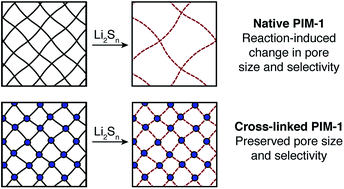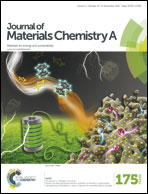Understanding and controlling the chemical evolution and polysulfide-blocking ability of lithium–sulfur battery membranes cast from polymers of intrinsic microporosity†
Abstract
Many next-generation batteries, including lithium–sulfur (Li–S) and redox-flow batteries, rely on robust and selective membranes to sustainably block the crossover of active species between the negative and positive electrodes. Preventing membrane degradation is essential for long-term battery operation. Nevertheless, challenges persist in understanding how to minimize the impact of chemical or structural changes in the membrane on its performance. Here we elucidate design rules for understanding and controlling the long-term polysulfide-blocking ability of size-selective polymer membranes cast from polymers of intrinsic microporosity (PIMs). PIM-1 membranes feature electrophilic 1,4-dicyanooxanthrene moieties that are shown to be susceptible to nucleophilic attack by lithium polysulfides, which are endogenous to lithium–sulfur batteries. Once transformed, the polymer chains reconfigure by swelling with additional electrolyte and the size-selective transport ability of the membrane is compromised. These undesirable, chemically-induced changes in membrane structure and selectivity were prevented by controllably cross-linking PIM-1. In doing so, low polysulfide crossover rates were sustained for >95 h, highlighting the critical role of macromolecular membrane design in the development of next-generation battery technologies.



 Please wait while we load your content...
Please wait while we load your content...